Chapter 15: Herbaceous Landscape Plants
Chapter Contents:
This chapter covers ornamental herbaceous plants in the context of the landscape – whether planted in the ground or used in containers and hanging baskets. Herbaceous plants can add color, texture, and interest to any landscape at any scale.

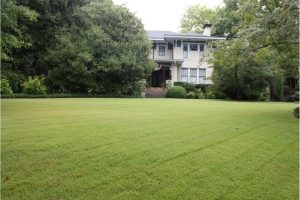
Throughout this chapter, think about the possibilities for expanding areas with herbaceous plants within your own garden and also how to recommend these plants and practices to others – part of your role as an Extension Master Gardener (EMG). Note this is written in context of the mid-Atlantic region.
An herbaceous plant is any vascular plant that isn’t woody, or a plant with woody stems that die back to the ground in the winter. Let’s break that huge quantity of species down into something a bit more useful. Herbaceous garden plants can be divided up by life cycle and/or physiology.
Annuals
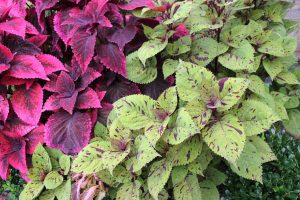
Annuals are not as straightforward as you might think. A “true” annual is something you can plant seeds of in the spring; it then flowers and sets seed (if not a sterile hybrid) before the growing season ends. Think “sunflower” (Helianthus annuus). However, we use the term “annual” for a lot of species that are actually perennial in their native environment - wherever that may be - they’re just not cold-hardy in your particular location. Nurseries, garden centers, and landscapers will often lump these together under the term "color." Another term is bedding plants, which encompass a wide variety of non-hardy, seasonal things like annuals, tropicals, herbs, vegetable transplants, etc. There are warm-season and cool-season annuals as well as those that do better is sun or shade. A vast palette of flower and foliage colors await the creative gardener - so many fun things for beds, hanging baskets and containers! We’ll talk more about annuals throughout this chapter.
Perennials
Perennials simply live for more than one growing season. Trees and shrubs are perennial. Orchids growing in southeast Asia are perennial. For our purposes, “perennial” means “herbaceous perennial,” and will refer to herbaceous plants that can tolerate freezing temperatures - a “hardy perennial."
Most perennials die back to roots/crown each winter but some species may remain evergreen or semi-evergreen, depending on location. Most temperate perennials (those native to moderate temperature regions without extreme cold or a tropical climate) also require a certain amount of cold, in both temperature and duration, to survive and rebloom. The higher the USDA hardiness zone, (i.e., zone 9 or 10) the fewer the number of temperate perennials that perform well. Classic perennials include Hosta spp., daylily (Hemerocallis spp.), purple coneflower (Echinacea spp.), etc.
Recommendations for perennials suitable for Virginia are available in the following publications:
- VCE Publication "Selecting Plants for Virginia Landscapes: Showy Flowering Shrubs" HORT-84P
- VCE Publication "Edible Landscape Species: Shrubs, Vines, Groundcovers" SPES-317P
- VCE Publication "For the Birds, Butterflies & Hummingbirds: Creating Inviting Habitats" HORT-59NP
- VCE Publication "Selecting Landscape Plants: Groundcovers" 426-609
- VCE Publication "Problem-free Shrubs for Virginia Landscapes" 450-236
- Plant Virginia Natives Regional Plant Guides
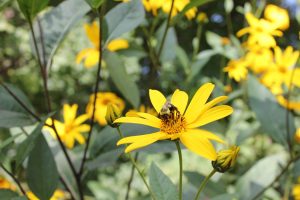
Is This Perennial Hardy or Not?
The United States Department of Agriculture’s Agricultural Research Service (ARS) Plant Hardiness Zone Map divides the U.S. into 13 zones according to the average of lowest minimum temperatures recorded for a 30-year period. Each of the 13 zones is further split into “a” (cooler) and “ b” (warmer). The current version of this map is based on 1976–2005 weather data, and it was updated in 2012 with GIS data, providing much more detailed information and revealing microclimates. The new map is online only, and is searchable by zip code or one can browse through and zoom in on a specific region or state.
The commonwealth of Virginia has a wide range of hardiness zones, due to our “sea-to-mountains” topography. Virginia Beach has the same hardiness zone (8a, 10 to 15 F) that stretches down the coast of the Carolinas and across central Georgia and Alabama. The piedmont region is zone 7: 7b east and south of Richmond and 7a west across central VA. As the elevation increases, the hardiness zone gets lower. The Blue Ridge and Allegheny mountains are mostly Zone 6b or 6a, with a few spots of 5b at the highest elevations. While Canna spp. and elephant ears (Colocasia spp.) may be reliably perennial in Suffolk, they probably will not survive the winter in Winchester.
These zones are referenced in gardening books, plant catalogs, and on plant tags and labels in order to help gardeners select plants appropriate to their growing area. Again, these zones are defined as "average annual extreme minimum temperature." For example, in Zone 6b, -5 to 0°F, it may not reach that low every year, though it could drop even lower. Keep in mind that cold hardiness is only one of many factors to impact herbaceous plant performance. Proper temperature acclimation, amount of light, soil moisture (too much or too little can be problematic), humidity, and heat tolerance all determine whether your plants thrive or not.
Biennials
Biennials possess a unique herbaceous lifecycle--vegetative growth occurs the first year. The next year the plants flower and set seed. The cold of winter in between serves to vernalize (cool the plants in order to encourage flowering) the plants, triggering the reproductive phase. For some plants, the vegetative phase is desired – herbs and leafy vegetables such as parsley, spinach, and lettuce. The flowering stage is called “bolting.” Ornamentals such as some, but not all, of the foxgloves (Digitalis ) and hollyhocks (Alcea) produce flowers during the second growing season, so planning ahead is required if growing them from seed. If happy with the garden site and situation, many biennials will freely reseed around.
Beyond classifications based on life cycle (annual, perennial, and biennial) , there are plenty of other herbaceous plant categories as well.
Tropicals
Tropicals are plants that lend a lush, exotic touch to the garden. For example, tropicals include broad or lush foliage from species we associate with tropical climates such as banana (Musa and Ensete), elephant ears (Colocasia, Alocasia), bamboo (Phyllostachys and many others), Canna and many more.
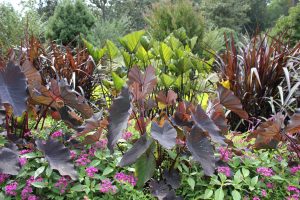
There are a few hardy species in each of these genera; however, most will not survive beyond Zone 8 or 9. The upside is they all grow rapidly if treated well (plenty of water and fertilizer), making a wonder show for the season. Bananas and elephant ears can be lifted and overwintered as house plants, or allowed to get “frosted” – the foliage knocked back by frost/freeze. Then you can cut back the tops, lift the roots or tubers, and store in a cool garage or basement. Plant into beds or containers after the threat of frost has passed in the spring. For more information on hardy tropicals, see the VCE publication "Cold-Hardy Topicals for Virginia Landscapes" 3005-1446.
Geophytes
Geophytes are herbaceous plants with underground storage organs, rather than fibrous root systems. Often lumped together under the generic term “bulbs,” these storage organs can also be corms, tubers, rhizomes, or other structures. These organs contain reserves of carbohydrates, nutrients, and water. Geophytes typically undergo a dieback or “dormancy” period, which varies depending on season of bloom.
Knowing when geophytes bloom is key to knowing when to plant them. Many summer-blooming geophytes, such as Dahlia and hybrid Gladiolus are not cold hardy and should be planted in late spring after all danger of freezing has passed.
Spring-blooming geophytes include those icons of spring: Crocus, tulip (Tulipa), and daffodils (Narcissus). Spring bloomers are generally cold-hardy perennials and are purchased and planted mid to late autumn. Just like holiday décor, spring bulbs are starting to show up in stores earlier and earlier – even in August. Do not plant until the weather is reliably cool and the soil temperature is below 50 degrees F. Never store purchased bulbs in the fridge – many veggies and fruit give off ethylene, which will damage the developing flower.

Types of Geophytes
Bulbs: The bulb itself is made of modified leaves or scales, with a compressed stem and a basal plate where roots emerge, like an onion. Once the flower has senesced (petals dropped off), the foliage persists for several weeks and then eventually declines, turning yellow or brown. This next bit of advice goes for ALL hardy geophytes: if you want the bulb to flower again next year, leave the foliage in place for as long as you can stand it. The photosynthetic process taking place in the leaves is putting critical carbohydrates back into the storage organ. Once the foliage is no longer visible, the bulb is not dormant! Flower primordia (the small buds at the end of stems from which flowers develop) are forming throughout the summer and autumn.
Corms: Storage structure is a modified stem with a basal plate – described as "solid bulbs.” Spring blooming (hardy) corms include Crocus. The summer bloomers include Gladiolus, Freesia, and Ixia.
Tubers: Thickened underground stem with no basal plate. Tubers such as Caladium have “eyes," meristematic tissue from which roots and shoots emerge, like potatoes that have been in the bin too long.
Tuberous roots: Thickened root tissue. Growth arises from buds at the top (crown) of the root mass. A piece of the crown must be included in any divisions. Includes Dahlia, Anemone x coronaria, and Ranunculus.
Rhizomes: Modified stems that grow horizontally at or below the soil surface. Rhizomatous perennials include German (bearded) Iris (Iris germanica), lily-of-the-valley (Convallaria majalis), Calla, and Oxalis.
Enlarged hypocotyl: Sounds painful, but the storage organ is simply the swollen portion of the stem below the cotyledon and above the roots. Cyclamen and Gloxinia are examples.
Pond and Bog Plants
Creating an ornamental pond, container water garden, or bog opens the door to another unique suite of herbaceous plants. Pond plants are not only beautiful, they are essential to a healthy pond, in that they take up excess nutrients such as nitrogen and phosphorus (both excreted by fish and created as organic matter such as leaves break down), provide shade to keep water temperatures down in summer, and help hide fish from predators. A naturally-maintained water garden attracts and nurtures wildlife of all kinds, from salamanders to birds, bees to mammals.
Pond Plants Categories
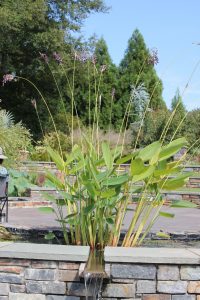
Floating plants (free-floating): These plants have buoyant leaves--no rooting situation is required. The floating roots excel at absorbing excess nutrients. Two popular species are water lettuce (Pistia stratioites) and water hyacinth (Eichornia crassipes).
Though considered invasive in the deep South and tropics, neither are freeze tolerant. Because they do not overwinter, they are not a problem here.
Submerged plants: These plants root into the gravel and remain under water, providing valuable oxygenation to the water as well as a great shelter for fish and other critters. Canadian water weed (Elodea canadensis) and ribbon grass (Vallisneria americana) are both native and cold-hardy additions to a Virginia pond.
Floating foliage, rooted to pond bottom (or containers): Leaves floating on or held at the surface keep water cool and the shade provided reduces algae growth. Two of our most iconic aquatic plants – water lily (Nymphaea) and lotus (Nelumbo) fall into this category. Cold-hardy and tropical varieties are available of both.
Marginal plants or “emergent”: These are the plants that thrive in shallow water, from a few inches up to 1’. These can be grown either rooted into a gravel substrate or in containers placed in several inches of water. There are many, many species, several of which are native to the Southern U.S., such as alligator flag (Thalia dealbata), pickerel weed (Pontedaria cordata), and cattails (Typha latifolia).
Bog Plants
Bog plants are a bit different – they require consistently moist soil but cannot tolerate standing water for long periods of time. Full sun and low soil pH (amended with peat) are also necessary for a successful bog garden. Pitcher plants (Sarracenia) are fascinating and easy to grow, once the site needs have been met. Look for cold-hardy species such as S. purpurea and S. flava.
Proper maintenance of pond plants is important to the health of the pond. Nearly all are deciduous, so once cold temperatures have knocked back the above-surface foliage and flowers, the dead plant material needs to be removed immediately. Organic matter that falls to the bottom of the pond not only forms a layer of glop, but decomposes with the help of bacteria that also use up valuable oxygen. Timely removal of leaves and other debris is essential to a healthy water garden.
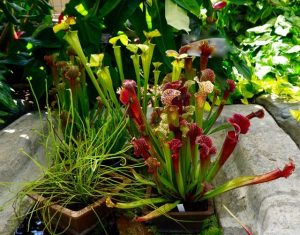
Ornamental Grasses
As a landscape plant category, ornamental grasses includes “true” grasses, that is, members of the Poaceae family, as well as grass-like plants such as rushes (Juncaceae) and sedges (Cyperaceae). Turf-type grasses are not included. How do we distinguish among these? True grasses are monocots, with round but hollow stems (called “culms”), and parallel veins in the leaves. There is such a wide range, but one example is little bluestem (Schizachyrium scoparium). Rushes also have round (and frequently unbranched) stems, but are filled with pith and not hollow. Sedges bear triangular stems - hence the old plant id tip: “rushes are round and sedges have edges.” Rushes and sedges prefer moist soil. Many grasses are very drought tolerant.
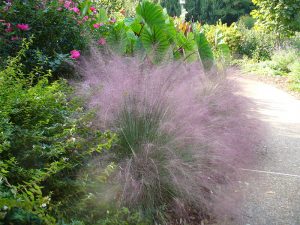
Most ornamental grasses are hardy perennials, but a few are not hardy and should be used as annuals. The most popular non-hardy grass is purple fountain grass (Pennisetum x advena ‘Purpureum’ and additional cultivars).
There are a vast number of perennial grasses, sedges, etc. for USDA Zones 5-8. Ornamental grasses can provide three to four seasons of interest: foliage color and texture for spring and summer, blooms in summer or fall, fall foliage color, and winter structure. Add to the list of positives “deer resistant” and “drought tolerant” for most species. Knowing the growth habit of a species is important when deciding where to plant – many are clumping (caespitose), but a few are either stoloniferous or rhizomatous runners. When planting, allow sufficient space – a good rule of thumb for many is to space plants as wide as they are tall. An exception would be an extremely narrow/vertical grass such as feather reed grass. Several wonderful native species have extensive root systems, for example, switchgrass (Panicum virgatum) roots can extend several feet below the soil surface. Take this into account when deciding where to plant; after a few years, relocation can become difficult.
Once planted and established, the only maintenance required for true grasses is to cut back the previous year’s growth in early spring before the new growth gets going. A 6-12 inch “crew cut” made with shears or a string weeder works well for most.
Unlike most true grasses that require at least six to eight hours of full sun each day, there are many shade-tolerant sedges – a textural boost to the shade garden. Most Carex are evergreen or semi-evergreen and rather slow growing. Do not cut them back annually, only trim out dead foliage.
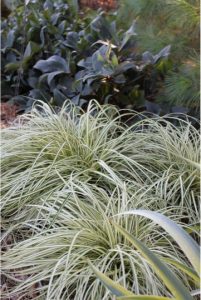
Ferns (Pterophytes)
Ferns are herbaceous but non-flowering. They have a completely different reproductive physiology, which is fascinating but beyond the scope of this chapter. Hardy ferns are indispensable in the shady or partially-shaded garden. Ferns are deer-resistant and the ultimate “mixer” – adding wonderful texture and no-fuss foliage. Green goes with everything, and in the case of Japanese painted fern (Athyrium nipponicum ‘Pictum’), silver and burgundy does as well. Mix ferns in with Hosta, Heuchera, Carex, and other shade perennials to form a shady tapestry of color. There are a wide array of perennial ferns available, from the petite deer fern to majestic cinnamon ferns.
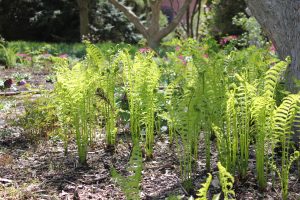
Most do best with reasonably moist soil but can tolerate short periods of drought. Most are deciduous, but our native Christmas fern (Polystichum acrostichoides) is evergreen. Simply cut back dead or tattered fronds in the winter and early spring, before the fiddleheads arise in spring. Note some ferns are slow to emerge in spring, so be patient! This works to your advantage in filling in gaps left by ephemeral shade perennials such as Virginia bluebells (Mertensia virginica) and bleeding hearts (Lamprocapnos spectabilis).
Succulents
Succulents are another broad group. Some are hardy (Sedum and Sempervivum species), but many are not (jade plant, Crassula argentea). The popularity of succulents as non-demanding, low water use container and patio plants has soared over the past few years. Sedums form the primary matrix for green roof plantings. Fleshy stems and “leaves," thick waxy cuticle, and other adaptations allow succulents to survive very dry conditions. Many succulents are in the Crassulaceae family, and have the capacity for CAM – crassulacean acid metabolism. In a nutshell, this is a water-saving strategy that allows stomates to close during the day when hot and dry, thus conserving water, and open at night for gas exchange. Succulents are extremely low maintenance and terrific for containers, patio gardens, or sunny windowsill plants. Most will suffer if overwatered. Use a light hand, especially during cool and cold weather.
Adapting the Garden for Therapeutic Benefits
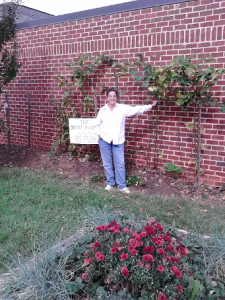
By Phyllis Turner, Extension Master Gardener, Bedford
Research has shown that gardening is a great activity to improve and maintain both physical and emotional well-being. However, a bit of creativity may be needed to adapt the garden to meet the needs of the gardener. The gardens at Bedford Nursing Home, developed by Bedford Extension Master Gardeners, exemplify the many benefits of a therapeutic garden. Enjoyment of home-grown fruits, veggies, and flowers is an added bonus to the nursing home residents.
Developed in 2008, the therapeutic garden project provides horticulture-related activities each month for residents living at a long-term care facility. When weather permits, activities are held outside and utilize several types of raised beds and containers: a low raised bed with trellis and bean pole, a deep raised bed that allows the gardener to be seated on the side of the garden, an elevated bed that accommodates gardening either standing or sitting in a chair. When weather keeps residents indoors, horticulture-related activities include workshops such as making potpourri from dried plants, seed and acorn art, and holiday decorations. Discussions about propagating plants, birds in the garden, pollinator gardens, and insects in the garden are more examples of activities.
All activities include both therapeutic and educational objectives. Some of the benefits that residents get from the project include: a connection with the environment, reversal of dependency, improvement of self-esteem, positive mental state, impact on a living thing, anchor in reality, and improvement in communications.
A picture says more than words about the self-esteem a resident gets from harvesting their own peanuts not to mention the satisfaction of Extension Master Gardeners sharing their love of gardening! It’s a win-win for everyone.
Bedford Nursing Home is a full partner in this project and provides financial support for the garden. This is important for the success of the program.
Planning the Herbaceous Border
Much of the excitement of creating a herbaceous border or mixed border (herbaceous combined with woody plants) lies in endless options of plant shapes, sizes, colors, and textures. In form, placement, and selection of plants, the contemporary border follows few rigid rules and allows fullest expression of the gardener’s taste.
The first step in planning the material for an all-season, mixed border is to select key plants for line, mass, color, and dependability. Line is the silhouette or outline of a plant, color is the tint or tone of any color on the color wheel, mass is its shape or denseness, and dependability refers to its ability to remain attractive with a minimum of problems. There are literally hundreds of gardening websites, blogs, Pinterest pages, books, videos, and catalogs for reference.
The most attractive herbaceous or mixed borders are those which are located in front of some sort of background, such as a fence, shrubbery, or a structure. In some cases, taller ornamental grasses or masses of large perennials such as blue false indigo (Baptisia australis) may serve a dual purpose as both citizens in the border and as background plants.
A general rule is to avoid a ruler-straight front edge, unless the garden is very spacious or formal. A gentle to boldly sweeping curve, easily laid out with a garden hose, is best even along a fence. The border can taper as it recedes from the main viewing point if an effect of distance is desired. The deeper the curve, the slower the eye moves and the greater will be the visual enjoyment. A border outlined with bricks or flat stones set flush with the soil may be better than a steeply cut lawn edge which must be trimmed after mowing.
Even the advanced gardener finds it advantageous to plan a border to scale on graph paper. The hardest task, organizing the selection of plants, will be simplified if only two main mass forms are considered: drifts and clumps. Drifts are elongated groupings of a plant that flow through sections of the border. Clumps consist of circular groupings of a variety, or a single large plant such as a peony (Paeonia spp.). The length of drifts and the diameter of clumps, as well as their heights, should be varied for best effect, and the dimensions should always be in proportion to the overall size of the border.
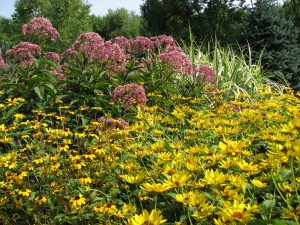
Establish plants in groups large enough to form masses of color or texture. As a rule, five to seven plants will create the desired effect. A large peony or grass will be of sufficient size to be attractive, but a random collection of different small to medium sized plants will present a disorganized, checkerboard appearance. Each group of flowers should have an irregular shape. These masses of color and texture should blend into a pleasing, natural pattern of color harmony, instead of rows, blocks, or other symmetrical designs (except in a formal garden).
Flower borders may be of any width, depending on the space available. In a small yard the bed may be only 2 or 3 feet wide. In a spacious location, the border planting may have a width of 6 or 8 feet. If the border is quite deep, a pathway of stepping stones may be helpful as a means of working among the flowers without compacting the soil.
Tall flowers should be selected for the back part of the bed, with medium-height species in the middle, and smaller varieties along the front as edging plants. This is very easily done because the height of all varieties is stated in seed catalogs. Plants along the front edge of the bed should be located far enough back to allow easy mowing of the lawn.
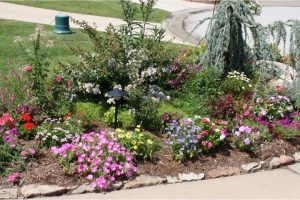
Plant height is best limited to 2/3 the width of the border, e.g., no plants taller than 4 feet in a border 6 feet wide. Height lines should be broken up by letting some tall plants extend into the medium height groups, with a few recessed clumps or drifts leading the eye back into the border. This gives a more natural effect than a step profile. Try to vary heights, but in general keep taller plants in the back and shorter ones toward the front.
The distance between plants in a flower border depends on the form of the individual plants and the effect which is desired in the landscape. Allow adequate space between plants but just to a point. Plants will grow; gardens are dynamic entities! If they become overcrowded, just remove the excess (and share with your friends).
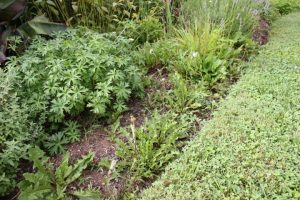
The enormous color range in perennials, plus their easy relocation if disharmony occurs, gives the gardener great latitude in choosing and combining colors. A border in tones of the same color can be effective, several closely related colors may be used, or the border may be made wildly exuberant with a vast variety of hues in one or more seasons. (Hues are modifications of color such as orange-red.) The objective is a balanced composition in every season, with no section being at any time too heavily weighted with one color, and the bloom distributed so that it always makes a pleasing pattern through the bed.
Many gardening books give excellent lists of compatible colors; these plus a garden notebook and camera are invaluable for planning and revising color schemes. For real floral artistry, it is perhaps more important to consider intensity, which is the vividness of a color, rather than hue. For example, light tones placed near dark ones, or contrasting palest tones with the most intense, can give new interest and life to the border. Also consider location and color. White is especially good near patios because it shows up well in the evening or dusk hours when patios are often in use. Some colors are suitable only as dramatic accents: deep, pure red clashes with almost anything (unless softened by dark green foliage), yet properly used it evokes strength and depth. White flowers and gray foliage are indispensable as separators of conflicting colors. Red, orange, and yellow are warm colors. Blue, green, and violet are cool colors.
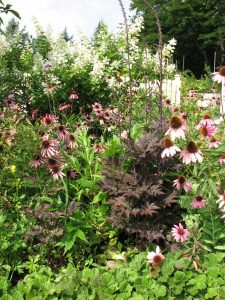
Even in a small border, single plants of different varieties should not be used as it gives a jumbled look. Do not set in precise rows but in groups, as they might grow in nature. Allow enough space for each group to grow comfortably. Pick a few plant combinations and let these be the basis of your planting. Replicating these groupings down the length of the border guides the eye. Repetition is pleasing to a point, but don’t overdo any one plant. Do not confine yourself to material that blooms all at one time and aim for a steady succession of color.
As gardeners become adept at producing color harmony and combinations in the border, they become more aware of the roles played by plant forms and foliage. Good foliage is obviously vital in plants with short blooming periods. Consider how much of the plant foliage will be usable and whether it is a positive or negative attribute. Some plants practically disappear when their blooming season is over (i.e., oriental poppy (Papaver) and bleeding heart), but others stay presentable even when not in flower. Plants with distinctive forms, color, and foliage — airy and delicate, or strong and solid — are wonderfully useful for creating interest. Shrubs with burgundy, maroon, or gold foliage, ornamental grasses, and even handsome-foliaged vegetables like chard and kale can be used for effect.
The most logical way to choose plants is first by location, second by period of bloom, then by height and width, and finally by color. Location takes into account the amount of sun or shade and water required. This information is easy to find in books or on the internet.
A last bit of advice: don’t be afraid to be bold, even if it results in some mistakes. Flowers are easy to move, change, or take out altogether. There is no need to be conservative or confined. Most herbaceous plants are fast growers and can be transplanted at almost any time to help create the desired effect.
Table 15-1: Made in the shade (or part shade)
A simple, three-season (or four-season, depending on severity of winter) garden of non-fussy, easy-care hardy perennials.
| Scientific name | Common name | Relative height | Description | Other notes |
|---|---|---|---|---|
| Asarum canadense | Deciduous ginger | Low | Wonderful native groundcover with iridescent, kidney shaped leaves. Forms large colonies where happy. | Native |
| Begonia grandis | Perennial begonia | Low to medium | Bold paisley-shaped leaves with reddish undersides and stems, soft pink blooms mid-summer through frost. | Late to emerge, so don’t forget it’s there! Non-native. |
| Eurybia divaricata | White wood aster | Low | Clouds of white aster flowers in late summer and early fall, when little else is blooming in the shaded. | Native, low growing |
| Helleborus x hybridus | Hellebore, Lenten rose | Medium | Earliest of spring flowers (late winter in warm areas). Cream to lavender to deep purple. Leathery evergreen foliage. | Non-native. Great early pollen source for bees. Extremely deer-resistant. |
| Hosta species and hybrids | Hosta, plantain lily | Low to medium | It’s all about the foliage. So many gorgeous cultivars to choose from – gold to blue-green to variegated. | Non-native. Unfortunately delicious to deer and rabbits. |
| Polygonatum odoratum ‘Variegatum’ | Variegated Solomon’s Seal | Medium | Cream and green foliage graces arching stems. White bell-shaped flowers dangle from leaf nodes in spring. Great yellow fall color. | Non-native but a must-have plant. |
| Matteuccia struthiopteris | Ostrich fern | Medium to tall | Vase –shaped clumps of broad, feathery fronds. Wonderful texture and height. Spreads by rhizomes to form new clumps – easy to remove (and share with friends!) if need be. | Native across most of the N. hemisphere. Deer-resistant. |
| Stylophorum diphyllum | Celandine poppy | Medium | Spring bloom with bright yellow poppy flowers and interesting foliage. Reseeds around where happy. | Native |
Table 15-2: Sure things for sun
Some flowers, some foliage, all easy and wonderful
| Scientific name | Common name | Relative height | Description | Other notes |
|---|---|---|---|---|
| Amsonia hubrichtii | Blue star | Medium | Thin foliage forms perfect mounds. Light blue flowers in spring, terrific texture in summer, then stunning gold to bronze fall color. | Native to OK + AR. Give it a year or two to reach full size. Deer-resistant. |
| Asclepias tuberosa | Orange milkweed | Low | Bright orange umbels in summer are beloved by butterflies and avoided by deer. | Native. Late to emerge, don’t move once established (tap root). |
| Calamagrostis x acutiflora ‘Karl Foerster’ | Feather reed grass | Medium to tall | The vertical form of stems and plumes makes exclamation points throughout the garden. Does not spread. Early summer blooms. | Non-native. Cut back in early spring for a fresh flush of growth. |
| Echinacea species and hybrids | Purple cone flower | Medium | Some of the older E. purpurea and E. tennesseensis cultivars are tougher and longer-lived than the fancy new hybrids. | U.S. Native. Tolerates most soils. Attracts bees and butterflies. |
| Eutrochium purpureum, E. maculatum, and E. dubium (previously Eupatorium genus) | Joe-Pye weed | Tall | Large umbels of silvery-pink to pale purple flower heads, interesting foliage on tall, strong stems. Try compact cultivars such as ‘Little Joe’ and ‘Phantom’ for the smaller garden. | Native. Brings bees and butterflies. Tolerant of wet soils. |
| Sporobolus heterolepis | Prairie dropseed | Low to medium | The fine foliage forms graceful mounds, accented by sprays of flowers in late summer. Drought and clay tolerant. | U.S. Native. Deer-resistant. |
| Symphyotrichum oblongifolium |
Aromatic aster | Medium | Shrubby habit, smothered with lavender flowers throughout fall; often last option for bees and other pollinators | Native. Deer-resistant. |
Containers and Hanging Baskets
Gone are the days of “monoculture” hanging baskets of impatiens or begonias. Mixed baskets and containers present an opportunity to combine foliage and flowers into portable works of art. Tropicals, perennials, annuals, and grasses can all co-exist in the same vessel. Though there are very few rules for containers and baskets, here’s a few tips for success:
- Confirm that the plants are compatible for the same environmental conditions, mainly light level (sun versus shade) and water (drought tolerant, needs consistently moist soil, etc.).
- Use the largest container or basket possible for the space and your budget. All those 4” containers of annuals are going to grow throughout the season, so give them some space to flourish. Big containers and big (14” diameter or larger) baskets make wonderful focal points for patios, decks, and borders.
- Add some controlled-release fertilizer to the media when filling the container or basket, and be sure to top-dress with a bit more fertilizer later in the summer. Frequent watering will leach nutrients out rapidly, resulting in chlorotic (yellowing) foliage and reduced blooms and vigor.
- When picking out plants for containers, look for three components: thriller, filler, and spiller. This bit of wisdom works like a charm. Pick a strong vertical component – grasses, Canna spp., elephant ears, or anything else with a bold upright habit. Add something to fill around the bare soil at the base – coleus (Solenostemon scutelleriodes) is ideal but so are dozens of other goodies. Plants that spill from the container soften the edges and complete the picture – chartreuse or maroon ornamental sweet potato (Ipomoea batatas), a cascading petunia, or myriad other options work well.
Additional Resources
Books:
- Matlack, K., Matlack, C., and Matlack J. (2009). Container Gardening: 250 Design Ideas & Step-by-step Techniques. Taunton.
- Perennials: Armitage, A. M. (2008). Herbaceous Perennial Plants: A Treatise on Their Identification, Culture, and Garden Attributes. Stipes.
- Perennials: DiSabato-Aust, T. (2007). The Well-tended Perennial Garden: Planting & Pruning Techniques. Timber.
- Ferns: Olsen, S. (2007). Encyclopedia of Garden Ferns. Timber.
- Pond Plants: Speichert, C. G. and Speichert, S. (2008). Timber Press Pocket Guide to Water Garden Plants. Timber.
- Succulents: Baldwin, D.L. (2013). Succulents Simplified: Growing, Designing, and Crafting with 100 Easy-care Varieties. Timber.
- Ornamental Grasses: Darke, R. (2007). The Encyclopedia of Grasses for Livable Landscapes. Timber.
- Ornamental Grasses: Darke, R. (1999). The Color Encyclopedia of Ornamental Grasses: Sedges, Rushes, Restios, Cat-tails, and Selected Bamboos. Timber.
- Ornamental Grasses: Greenlee, J., Holt, S. (2009). The American Meadow Garden: Creating a Natural Alternative to the Traditional Lawn. Timber.
- Geophytes: Bryan, J. E. (2005). Timber Press Pocket Guide to Bulbs. Timber.
Attributions
- Stacey Morgan Smith, Extension Master Gardener (2022 reviser)
- Elaine Mills, Extension Master Gardener, Arlington/Alexandria (2022 reviser)
- Holly L. Scoggins, Associate Professor, Horticulture (2015 reviser)
- Diane Relf, Extension Specialist, Horticulture (2009 reviser)
Image Attributions
- Figure 15-1: Lawn, shrubs, trees, but no herbaceous plants: boring! Master Gardener Training Handbook, Virginia Cooperative Extension, 2018. CC BY-NC-SA 4.0.
- Figure 15-2: Much better! Master Gardener Training Handbook, Virginia Cooperative Extension, 2018. CC BY-NC-SA 4.0.
- Figure 15-3: Coleus are available in an array of colors and leaf shapes, perfect for sun or shade. Master Gardener Training Handbook, Virginia Cooperative Extension, 2018. CC BY-NC-SA 4.0.
- Figure 15-4: The best perennials, such as this native perennial sunflower (Helianthus divarioatus) provide color, beauty, and pollen and / or nectar for bees, butterflies, and other pollinators. Master Gardener Training Handbook, Virginia Cooperative Extension, 2018. CC BY-NC-SA 4.0.
- Figure 15-5: Tropicals. Master Gardener Training Handbook, Virginia Cooperative Extension, 2018. CC BY-NC-SA 4.0.
- Figure 15-6: Daffodils. Master Gardener Training Handbook, Virginia Cooperative Extension, 2018. CC BY-NC-SA 4.0.
- Figure 15-7: Thalia adds vertical interest to any water feature. Master Gardener Training Handbook, Virginia Cooperative Extension, 2018. CC BY-NC-SA 4.0.
- Figure 15-8: Pitcher Plants (Sarroenia) can be grown in containers as well as bogs. Master Gardener Training Handbook, Virginia Cooperative Extension, 2018. CC BY-NC-SA 4.0.
- Figure 15-9: Muhly grass. Kennedy, Ken on Flickr. CC BY-SA 2.0
- Figure 15-10: Carex oshimensis "Evergold" adds wonderful texture and color to the shade garden and is evergreen in the warmer parts of Virginia. Master Gardener Training Handbook, Virginia Cooperative Extension, 2018. CC BY-NC-SA 4.0.
- Figure 15-11: The fresh, bright green fronds of ostrich fern blends well with other shade perennials. Master Gardener Training Handbook, Virginia Cooperative Extension, 2018. CC BY-NC-SA 4.0.
- Figure 15-12: Linda Esser, Bedford Extension Master Gardener Pruning the thornless blackberries at the therapeutic garden. Turner, Phyllis. 2022. CC BY-NC-SA 4.0.
- Figure 15-13: Masses of Joe-Pye weed, Heliopsis, and grasses make an impact. Master Gardener Training Handbook, Virginia Cooperative Extension, 2018. CC BY-NC-SA 4.0.
- Figure 15-14: One of everything ("flower confetti") rarely produces desirable results! Master Gardener Training Handbook, Virginia Cooperative Extension, 2018. CC BY-NC-SA 4.0.
- Figure 15-15: Any open space invites weeds! Keep that in mind for the very front border as well. Master Gardener Training Handbook, Virginia Cooperative Extension, 2018. CC BY-NC-SA 4.0.
- Figure 15-16: Warm, rosy pinks and purples work well together. Master Gardener Training Handbook, Virginia Cooperative Extension, 2018. CC BY-NC-SA 4.0.
Plants that pass through their entire life cycle from seed germination to seed production in one growing season, then die
Encompass a wide variety of non-hardy, seasonal things like annuals, tropicals, herbs, vegetable transplants, etc.
Plants that live for many years. May be herbaceous or, if significant xylem develops in the stem and the top persists, may be classified as woody.
Perennials native to moderate temperature regions without extreme cold or a tropical climate
Plants that start from seeds and produce vegetative structures and food storage organs the first season and flowers, fruit, and seeds the second season
Cool the plant in order to encourage flowering
Herbaceous plants with underground storage organs, rather than fibrous root systems
Shortened, compressed, underground stems surrounded by fleshy scales (leaves) that envelop a central bud located at the tip of the stem
The small buds at the end of stems from which flowers develop
A solid, swollen stem whose scales have been reduced to a dry, leaf-like covering. They have shapes similar to bulbs, but do not contain fleshy scales.
Enlarged portion of an underground stem. The tuber, like other stems, has nodes that produce buds.
Underground storage organ
Specialized stem that grows underground and sends out roots and shoots from nodes
Storage organ, the swollen portion of the stem below the cotyledon and above the roots
Members of the Juncaceae family of flowering plants; distinguishable from grasses and sedges by their round (and frequently unbranched) stems filled with pith (not hollow)
Members of the Cyperaceae family of grass-like monocotyledonous flowering plants; distinguishable from rushes and grasses by their triangular stems
Class of herbaceous vascular plants that reproduce via spores

